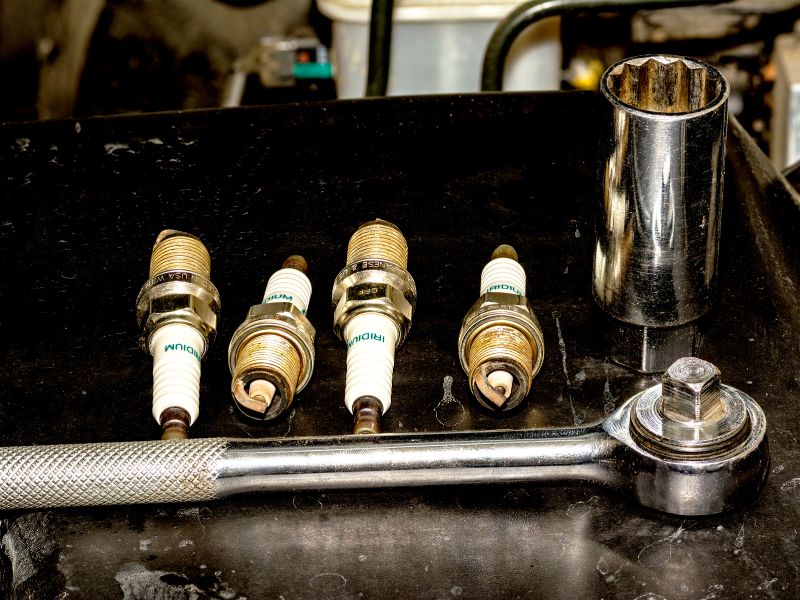There are three things a gasoline engine needs to function, fuel, spark, and compression.
Take any of those three away, and it won’t run, and in this article, we are focusing on bad spark plug symptoms:
- Engine Struggles To Start
- Rough Idle
- Worse Fue Consumption
- Worse Performance
- Engine Misfire
- Smell Of Gasoline
- Black Smoke From The Exhaust
- Engine Failure
With the symptoms listed, let me explain how to identify them and why it happens.

The 8 Bad Spark Plug Symptoms To Look Out For
To understand these symptoms, you first need to know the function of the spark plug; it ignites the fuel inside the combustion chamber of a gasoline engine (diesel does not have spark plugs).
It uses high-voltage electricity supplied by the coil or coil packs to throw a spark between the gap of the central electrode and the grounding electrode (ground strap).
1. Engine Struggles To Start
When a spark plug is dirty or broken, it can’t emit the spark to ignite the fuel; in many cases, spark plugs on an engine won’t fail all at once but one by one.
Since only one cylinder is not igniting the fuel, the engine struggles to start, and the more cylinders are not igniting the fuel, the greater the chance of it not starting.
The one cylinder that is not igniting is holding the other cylinders back by not providing any downward force onto the crankshaft, thus the engine struggling to reach idle rpm.
2. Rough Idle
Once the engine is running, you will notice the engine shaking and audibly running rougher than usual.
The reason for this is, again, with one or more of the cylinders not igniting the fuel, the idle speed will fluctuate whenever it is the turn of that bad spark plug to ignite the fuel.
Since one of the sparks per revolution isn’t working, you will hear the engine stumble.
3. Worse Fuel Consumption
With the engine not igniting all the fuel, it can’t produce the same amount of rotating energy on the crankshaft as before, and one or more pistons that aren’t igniting the fuel is more drag on the engine.
Thus keeping the car at a certain speed will need more fuel since there is more internal drag in the engine, and your throttle input will be greater than before.
4. Worse Performance
The vehicle’s power output will drastically decrease with the engine not igniting the fuel in all cylinders.
The car will be sluggish at acceleration, struggle to maintain a certain speed, and won’t be able to reach its top speed.
5. Engine Misfire
You can imagine that if one cylinder isn’t igniting the fuel, the fuel will end up in the vehicle’s exhaust and combust because of the hot exhaust gasses, causing a misfire.
This uncontrolled burning of fuel (misfire) can have catastrophic consequences, especially in turbocharged vehicles where the exhaust temperature even higher is and can cause the engine to detonate instead of combust.
6. Smell Of Gasoline
If you walk past a vehicle’s exhaust with a bad spark plug, you will be able to smell the unburnt gasoline, especially at idle.
The engine is constantly pushing fuel into the exhaust hence the smell.
7. Black Smoke From the Exhaust
Black smoke emitted from the exhaust will be seen once you start driving as the exhaust temperature rises.
The unburnt fuel will land in the exhaust and burn but not at an optimal rate; there is not much oxygen in the vehicle’s exhaust, and thus black smoke will appear.
8. Engine Failure
With prolonged driving with a bad spark plug, the fuel inside the cylinder will wash away the oil on the sleeve.
With no oil on the sleeve of the cylinder, the piston rings don’t have a smooth, lubricated surface to run on.
This, over time, will eat away at the piston rings and cause loss of cylinder compression and blow by where the fuel will enter the vehicle’s oiling system, and oil can enter the combustion chamber.
At that point, you will need to rebuild the engine, which costs a lot of money.

Final Thoughts On Bad Spark Plug Symptoms
While a bad spark plug causes inconveniences over an extended period, it can cause engine damage.
Replacing spark plugs is one of the more straightforward tasks you can do yourself, and Chrisfix has an excellent video showing you how:
Hopefully, you found this article helpful in recognizing the symptoms of a bad spark plug, and it will let you travel many trouble-free miles.

FAQs
Do Spark Plugs Affect Acceleration?
Yes, a gasoline engine produces power by igniting gasoline with the spark plug; if there is no spark, the cylinder with no working spark plug is not contributing to making power.
The piston of the affected cylinder is now causing resistance on the rotating assembly, taking away even more power.
What Should I Do After Changing Spark Plugs?
Ensure all the spark plug wires are connected at both ends, at the coil and the spark plug, or that the coil pack is securely tightened to the spark plug.
If everything is connected as it should, start the vehicle, and control if the spark plugs are working by hearing if the engine is running smoothly with no misfires.
What Does A Misfire Feel Like?
A misfire will feel like the engine loses all power for a split second; the car will stutter and continue to operate as usual until the next misfire.
